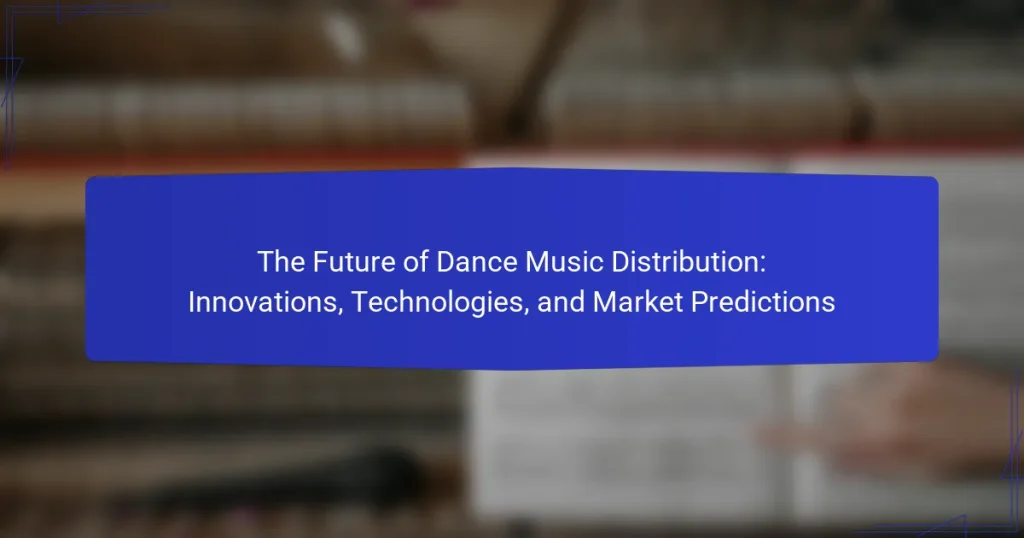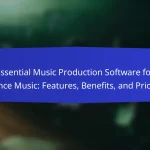The future of dance music distribution is poised for transformation through digital platforms and blockchain technology. Digital streaming services, such as Spotify and Apple Music, dominate the music consumption landscape, while blockchain enhances transparency and efficiency in royalty payments, fostering trust among artists. Emerging innovations like decentralized platforms enable direct-to-fan sales, empowering independent artists and reducing reliance on traditional labels. Additionally, artificial intelligence is set to personalize user experiences through advanced music recommendation systems. Market predictions indicate significant growth, with the global music distribution market projected to reach $10 billion by 2025, driven by the rise of streaming and social media engagement in dance music.
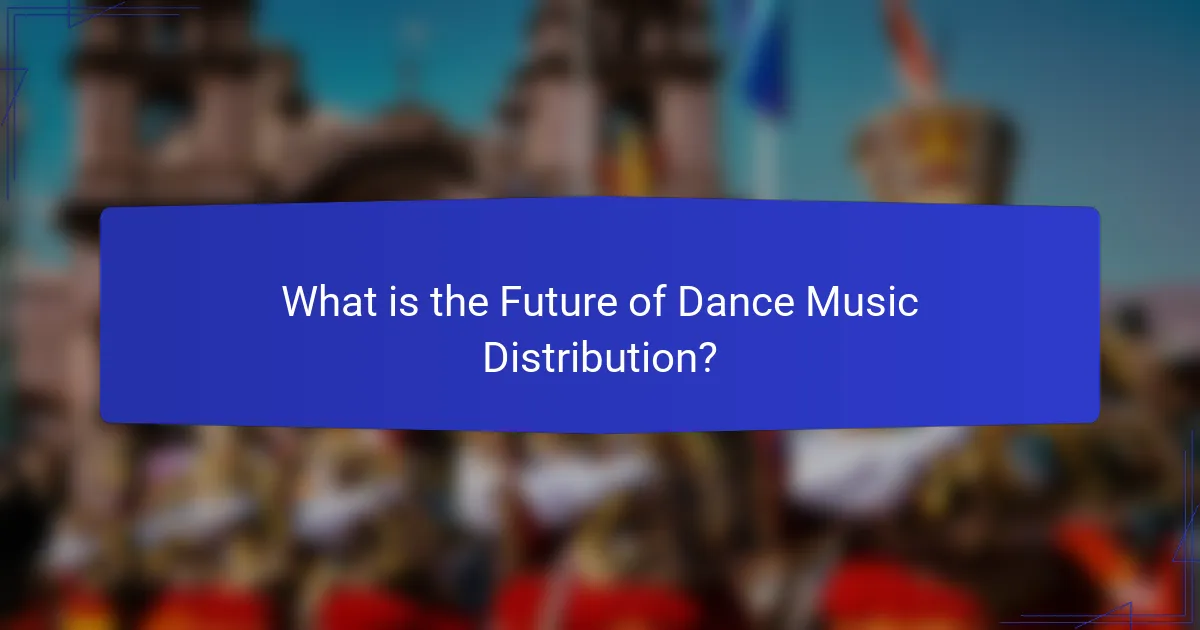
What is the Future of Dance Music Distribution?
The future of dance music distribution will increasingly rely on digital platforms and blockchain technology. Digital streaming services dominate music consumption, with platforms like Spotify and Apple Music leading the market. Blockchain offers transparency and efficiency in royalty payments, enhancing trust for artists. Direct-to-fan sales through social media will also rise, empowering artists to connect with their audience. The integration of artificial intelligence in music recommendation systems will personalize user experiences. Virtual reality and augmented reality may create immersive listening experiences, expanding distribution channels. Overall, technological advancements will reshape how dance music is produced, distributed, and consumed.
How is dance music currently distributed in the digital age?
Dance music is currently distributed through various digital platforms. Streaming services like Spotify and Apple Music dominate the market. These platforms allow artists to reach global audiences instantly. Digital downloads via platforms such as Beatport and Bandcamp remain popular among DJs and enthusiasts. Social media channels also play a crucial role in promotion and distribution. Artists often share tracks on platforms like SoundCloud and YouTube. This accessibility has transformed how fans discover and consume dance music. The shift to digital has increased competition among artists, leading to more diverse sounds and styles.
What platforms dominate the dance music distribution landscape?
Spotify, Apple Music, and SoundCloud dominate the dance music distribution landscape. These platforms are widely used by artists to share their music globally. Spotify boasts over 400 million active users, making it a top choice for music distribution. Apple Music has around 88 million subscribers, providing a robust platform for artists. SoundCloud is known for its community-driven approach, with over 76 million creators sharing their work. Additionally, Beatport serves as a specialized platform for electronic dance music, catering to DJs and producers. These platforms collectively shape how dance music reaches audiences today.
How do artists and labels leverage these platforms for distribution?
Artists and labels leverage digital platforms for distribution by utilizing streaming services, social media, and online marketplaces. They distribute music directly to consumers through platforms like Spotify and Apple Music. This allows for global reach and immediate access to audiences. Artists can also engage fans through social media channels, promoting their releases and building a following. Additionally, labels use online marketplaces like Bandcamp to sell music and merchandise directly to fans. This model increases revenue and fosters a closer connection with audiences. Statistics show that over 60% of music consumption occurs via streaming platforms, highlighting their importance in distribution strategies.
What trends are shaping the future of dance music distribution?
Increased digital streaming is shaping the future of dance music distribution. Platforms like Spotify and Apple Music dominate the market. They provide artists with global reach and instant access to audiences. Direct-to-fan sales are also on the rise. Artists leverage platforms like Bandcamp to sell music directly. This trend enhances artist revenue and fosters community engagement. Additionally, blockchain technology is emerging in music distribution. It offers transparent royalty payments and secure ownership rights. Social media platforms are increasingly becoming distribution channels. TikTok, for instance, drives music discovery and trends. These trends indicate a shift towards more accessible and artist-centric distribution models.
How are consumer preferences influencing distribution methods?
Consumer preferences are significantly influencing distribution methods in the dance music industry. The rise of digital streaming services reflects a shift toward convenience and accessibility. Consumers prefer platforms that offer instant access to music. This has led to a decline in physical sales and a focus on digital distribution. Data shows that over 60% of music consumption now occurs through streaming. Additionally, consumers favor personalized playlists and curated content. This trend encourages distributors to adopt algorithms that enhance user experience. As a result, distribution methods are increasingly tailored to meet consumer demands for immediacy and personalization.
What role does social media play in dance music distribution?
Social media plays a crucial role in dance music distribution by facilitating direct artist-to-fan engagement. Platforms like Instagram, Facebook, and TikTok allow artists to share new tracks and updates instantly. This immediacy helps create buzz and anticipation around releases. Additionally, social media algorithms can amplify reach, allowing music to be discovered by wider audiences. According to a 2021 report by MIDiA Research, 75% of music fans discover new music through social media. This highlights the platform’s influence on music consumption habits. Social media also enables viral marketing, where user-generated content can propel a track to popularity. Overall, social media is integral to how dance music reaches listeners today.
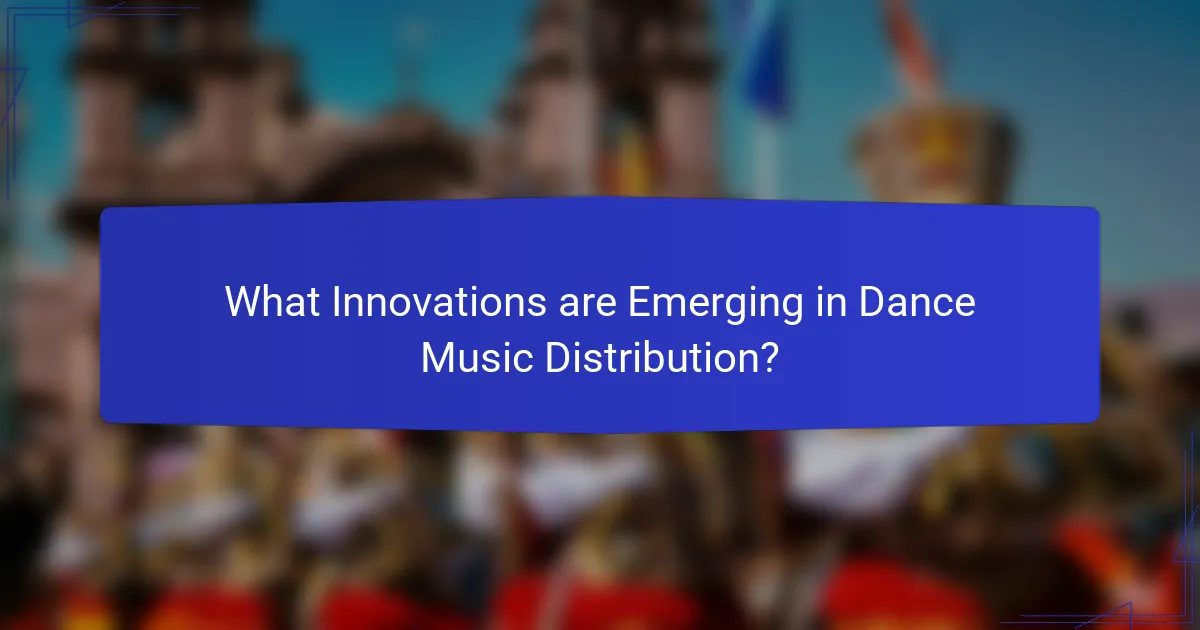
What Innovations are Emerging in Dance Music Distribution?
Emerging innovations in dance music distribution include blockchain technology, decentralized platforms, and AI-driven analytics. Blockchain enhances transparency and security for artists and consumers. Decentralized platforms allow artists to distribute music directly to fans, reducing reliance on traditional labels. AI-driven analytics provide insights into audience preferences and trends. These innovations facilitate fairer revenue sharing and empower independent artists. According to a report by the International Music Summit, blockchain could potentially increase artist earnings by up to 30%.
How are new technologies transforming the distribution process?
New technologies are transforming the distribution process by enhancing efficiency and accessibility. Digital platforms enable instant delivery of music to global audiences. Blockchain technology ensures transparent and secure transactions for artists and labels. Artificial intelligence streamlines marketing efforts by analyzing listener preferences. Data analytics provides insights into consumer behavior, allowing targeted promotions. Cloud storage facilitates easy access to music files for both creators and distributors. Social media integration allows for direct engagement with fans and promotes new releases. These advancements collectively reshape how music is distributed and consumed in the dance music industry.
What impact do blockchain and smart contracts have on distribution?
Blockchain and smart contracts significantly enhance distribution by providing transparency and security. They enable direct transactions between creators and consumers. This reduces the need for intermediaries, lowering costs. Smart contracts automate payment processes based on predefined conditions. This ensures timely and accurate compensation for artists. According to a study by Deloitte, blockchain can streamline supply chains, improving efficiency by up to 30%. Additionally, blockchain’s immutable ledger ensures that all transactions are traceable. This builds trust among stakeholders in the distribution chain. Overall, these technologies revolutionize how dance music is distributed, ensuring fairer and more efficient processes.
How are AI and machine learning enhancing music distribution strategies?
AI and machine learning are enhancing music distribution strategies by optimizing content delivery and personalization. These technologies analyze listener data to identify preferences and trends. This analysis allows platforms to recommend music tailored to individual tastes. Additionally, AI algorithms can predict which tracks are likely to succeed based on historical data. This leads to more effective marketing campaigns. Machine learning also streamlines distribution processes, reducing time and costs. According to a 2021 report by MIDiA Research, AI-driven recommendations can increase listener engagement by up to 30%. These advancements ensure that artists reach their target audiences more efficiently.
What innovative distribution models are being adopted?
Innovative distribution models being adopted in dance music include direct-to-fan sales, subscription services, and blockchain technology. Direct-to-fan sales allow artists to sell music directly to listeners, enhancing revenue. Subscription services like Spotify and Apple Music provide access to vast libraries for a monthly fee. Blockchain technology enables transparent and secure transactions, ensuring artists receive fair compensation. These models improve artist control over distribution and revenue streams. The shift towards digital platforms is evidenced by the rise of independent artists utilizing these methods to reach audiences directly.
How do direct-to-fan models change the traditional distribution approach?
Direct-to-fan models fundamentally alter the traditional distribution approach by facilitating direct engagement between artists and their audiences. This model eliminates intermediaries like record labels and distributors. Artists can now sell music, merchandise, and experiences directly to fans. This leads to increased revenue for artists, as they retain a larger share of sales. Additionally, direct-to-fan models foster stronger fan relationships through personalized communication. According to a 2021 report by Music Business Worldwide, artists utilizing this model saw revenue increases of up to 30%. This shift empowers artists to control their branding and marketing strategies effectively.
What are the benefits of subscription-based distribution services?
Subscription-based distribution services provide consistent access to music for artists and listeners. These services streamline the distribution process for music creators. They offer predictable revenue models through monthly fees. This model reduces upfront costs for artists compared to traditional distribution methods. Subscription services also enhance marketing opportunities through curated playlists. They provide analytics that help artists understand their audience better. Additionally, these platforms often include promotional tools to increase visibility. Overall, subscription-based services support both artists and consumers in a rapidly evolving music landscape.
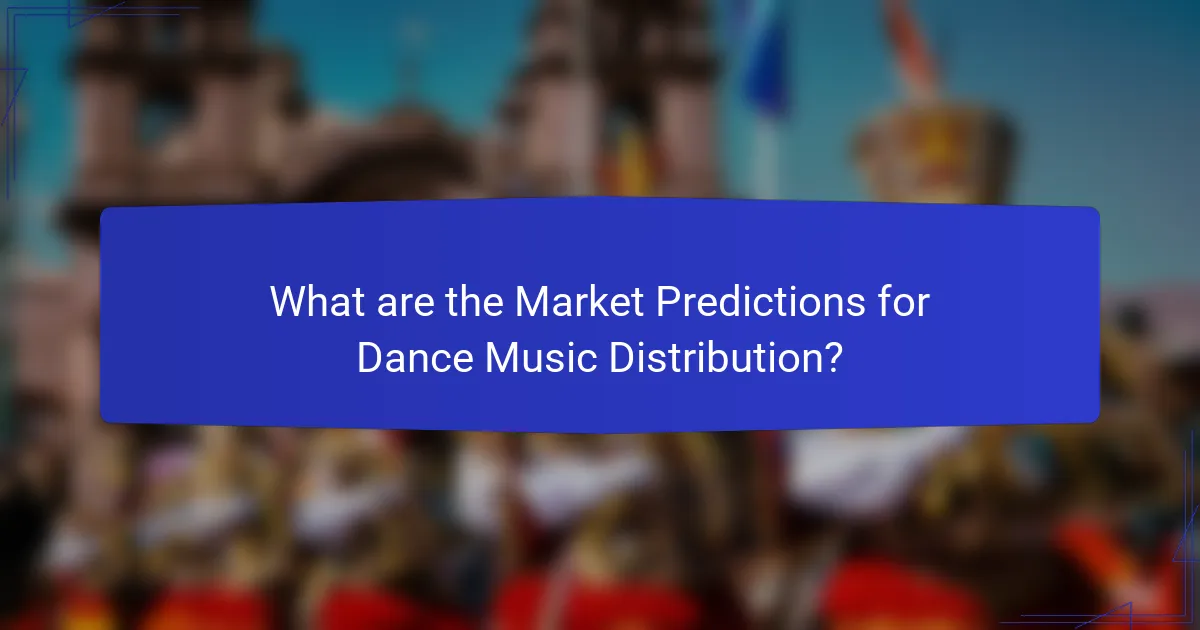
What are the Market Predictions for Dance Music Distribution?
The market predictions for dance music distribution indicate significant growth in the coming years. The global music distribution market is projected to reach $10 billion by 2025. This growth is driven by the increasing popularity of digital streaming platforms. Reports show that streaming accounts for over 80% of music revenue in many regions. Additionally, independent artists are gaining more opportunities through digital distribution channels. The rise of social media platforms is also influencing dance music’s reach and engagement. Research from MIDiA shows that dance music has a dedicated fanbase, with a 20% increase in streaming over the past year. These factors suggest a robust future for dance music distribution.
What does the data say about the future growth of dance music distribution?
The data indicates that dance music distribution is expected to grow significantly in the coming years. Market research shows a projected annual growth rate of 12% from 2023 to 2030. Streaming platforms are becoming the primary method for music distribution, accounting for over 70% of total revenue in 2022. The rise of digital sales and streaming is reshaping the industry landscape. Additionally, the increasing popularity of electronic dance music (EDM) festivals contributes to this growth. Reports highlight that global streaming revenue for dance music reached $1.5 billion in 2022. Innovations in technology, such as blockchain, are also enhancing distribution efficiency. Overall, the future growth of dance music distribution appears robust and promising.
How is the global market for dance music expected to evolve?
The global market for dance music is expected to grow significantly in the coming years. According to a report by Allied Market Research, the dance music market was valued at approximately $6.9 billion in 2021. It is projected to reach around $11.2 billion by 2031, with a compound annual growth rate (CAGR) of 5.1%. This growth is driven by increasing digital consumption and the rise of streaming platforms. Additionally, the popularity of electronic dance music (EDM) festivals continues to attract large audiences. Innovations in technology, such as virtual reality concerts, are also expected to enhance the experience and accessibility of dance music. Overall, the dance music market is poised for expansion due to these trends and developments.
What factors could influence the future market dynamics?
Technological advancements will significantly influence future market dynamics in dance music distribution. Innovations such as blockchain technology can enhance transparency and security in transactions. Streaming platforms are evolving, impacting how music is consumed and monetized. Consumer preferences are shifting towards personalized experiences, affecting content delivery methods. Social media trends can drive artist visibility and engagement, altering market strategies. Economic factors, including disposable income levels, will impact consumer spending on music. Regulatory changes may also affect distribution practices and artist compensation. These factors collectively shape the competitive landscape of the dance music market.
What strategies should artists and labels adopt for future success?
Artists and labels should adopt direct engagement strategies with their audience. This includes leveraging social media platforms for real-time interaction. Data indicates that 70% of fans prefer to connect with artists online.
Additionally, embracing digital distribution channels is crucial. Streaming services dominate music consumption, with over 80% of listeners using them. Artists should also explore non-fungible tokens (NFTs) to create unique experiences and ownership opportunities for fans.
Collaboration with other artists and brands can amplify reach. Statistics show that collaborative tracks often achieve higher chart positions. Finally, investing in data analytics will help understand audience preferences and tailor marketing efforts effectively.
How can artists effectively navigate the changing distribution landscape?
Artists can effectively navigate the changing distribution landscape by embracing digital platforms and social media. These channels allow artists to reach audiences directly and build a fanbase. Utilizing streaming services like Spotify and Apple Music is crucial for visibility. Artists should also explore decentralized distribution models, which offer more control over their music. Engaging with fans through platforms like Bandcamp enhances direct sales opportunities. Data analytics can inform artists about their audience’s preferences, guiding marketing strategies. Collaborating with other artists expands reach and introduces new listeners. Staying informed about industry trends ensures artists adapt to shifts in distribution methods.
What best practices should labels implement for optimal distribution?
Labels should implement data-driven strategies for optimal distribution. Utilizing analytics helps identify target audiences effectively. Labels should also establish strong partnerships with digital platforms. This enhances visibility and access to wider audiences. Regularly updating promotional materials keeps content fresh and engaging. Implementing a multi-channel distribution approach maximizes reach across various platforms. Consistent branding across all channels reinforces identity and recognition. Monitoring performance metrics enables continuous improvement and adaptation. These best practices align with industry trends and consumer behaviors.
What challenges might arise in the future of dance music distribution?
Future challenges in dance music distribution include piracy, market saturation, and evolving consumer preferences. Piracy undermines revenue for artists and labels. Market saturation leads to fierce competition among numerous artists. Evolving consumer preferences demand innovative distribution methods. Additionally, changes in streaming algorithms can affect visibility for emerging artists. The rise of artificial intelligence may complicate copyright issues. Finally, adapting to new technologies requires ongoing investment from stakeholders. Each of these factors poses significant hurdles for the dance music distribution landscape.
How can artists and labels prepare for potential obstacles?
Artists and labels can prepare for potential obstacles by developing comprehensive risk management strategies. They should conduct market research to identify trends and challenges in the dance music industry. Creating a diversified revenue stream is essential for financial stability. This can include merchandise sales, live performances, and digital content. Establishing strong relationships with distribution partners can mitigate logistical issues. Regularly updating their digital marketing strategies helps to adapt to changing consumer behaviors. Additionally, investing in legal counsel ensures compliance with industry regulations. These proactive measures can significantly reduce the impact of unforeseen challenges.
What solutions exist to address these challenges effectively?
Innovative technologies and platforms effectively address challenges in dance music distribution. Blockchain technology ensures transparent royalty payments and tracks music ownership. Decentralized platforms like Audius allow artists to distribute music directly to fans without intermediaries. AI-driven analytics provide insights into listener preferences, helping artists tailor their marketing strategies. Subscription-based models offer steady revenue streams for artists, reducing reliance on single sales. Collaborative tools enhance communication between artists, producers, and distributors, streamlining the production process. These solutions create a more equitable and efficient landscape for dance music distribution.
The main entity of this article is dance music distribution. The article explores the future of dance music distribution, highlighting the increasing reliance on digital platforms, blockchain technology, and the impact of artificial intelligence. It discusses current distribution methods, dominant platforms, and emerging trends shaping the industry, such as direct-to-fan sales and subscription services. The article also examines market predictions, consumer preferences, and strategies for artists and labels to navigate the evolving landscape while addressing potential challenges and innovative solutions.
